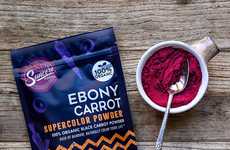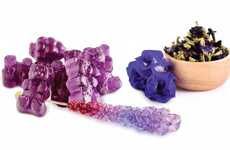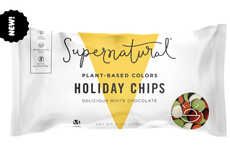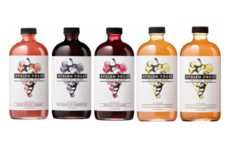
ColorKitchen's Sprinkle and Frosting Colors are Sourced from Nature
Laura McQuarrie — February 8, 2017 — Lifestyle
References: colorkitchenfoods & foodbusinessnews.net
Highly pigmented fruits and vegetables like beets, blueberries and carrots have been used for centuries as natural food coloring agents. However, over time they have fallen by the wayside, unable to compete with the convenience offered by synthetic food coloring substances that are neatly offered by the bottle.
At this year's Winter Fancy Food Show, ColorKitchen unveiled a range of new baking products with a focus on clean and allergen-free ingredients. One of its standout new products is the Rainbow Sprinkle Color Set, which provides a packet of sprinkles and frosting for cookies, cakes or cupcakes that are made from plant-based colors. For instance, the blue color comes from spirulina, yellow from turmeric and pink from beetroot powder.
Now that many consumers have become wary of artificial ingredients in food, it is becoming more important than ever for brands to consider reformatting their products with naturally sourced ingredients.
At this year's Winter Fancy Food Show, ColorKitchen unveiled a range of new baking products with a focus on clean and allergen-free ingredients. One of its standout new products is the Rainbow Sprinkle Color Set, which provides a packet of sprinkles and frosting for cookies, cakes or cupcakes that are made from plant-based colors. For instance, the blue color comes from spirulina, yellow from turmeric and pink from beetroot powder.
Now that many consumers have become wary of artificial ingredients in food, it is becoming more important than ever for brands to consider reformatting their products with naturally sourced ingredients.
Trend Themes
1. Plant-based Food Coloring - Brands can explore using plant-based ingredients to create natural food coloring, catering to the growing demand for clean and allergen-free products.
2. Clean and Allergen-free Baking - There is an opportunity for businesses to develop baking products that prioritize clean and allergen-free ingredients, tapping into the increasing consumer preference for healthier options.
3. Shifting Away From Synthetic Food Coloring - As consumers become more conscious about artificial ingredients, companies can capitalize on this trend by transitioning their products from synthetic food coloring to natural alternatives.
Industry Implications
1. Food and Beverage - Companies in the food and beverage industry can innovate by incorporating natural food coloring in their products, appealing to health-conscious consumers.
2. Baking and Confectionery - The baking and confectionery industry can embrace the use of clean and allergen-free ingredients, creating disruptive products that cater to health-conscious consumers' desires.
3. Food Packaging and Ingredients - Businesses in the food packaging and ingredients industry can explore providing natural food coloring solutions to enable brands to shift away from synthetic alternatives, meeting the demands of conscientious consumers.
1.9
Score
Popularity
Activity
Freshness























